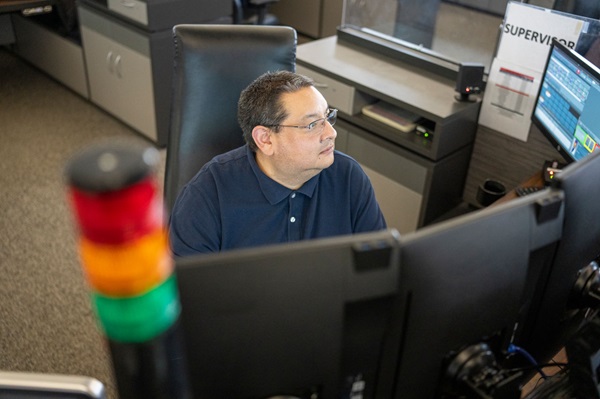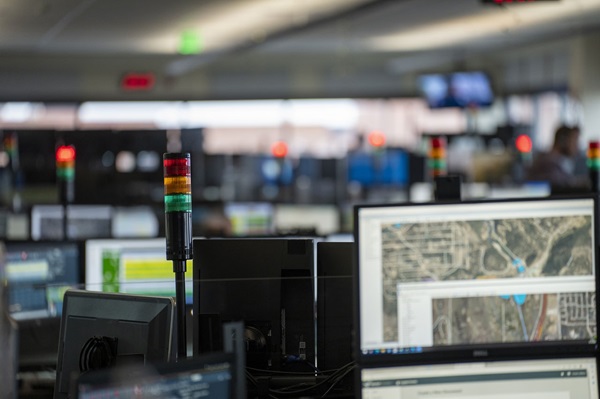The person who answers your call when you dial 9-1-1 is probably not someone that you think about… until you actually need to dial 9-1-1. Even then, you’re probably much more concerned about the situation that required a 9-1-1 call than the person assisting you with that emergency. That individual — officially known as a “telecommunicator” — actually works in one of the most challenging environments in public safety.
Of course, we would expect the unknown aspect of answering a 9-1-1 call to be stressful. Each call could be anything — from managing a life-or-death situation to a minor issue that probably doesn’t actually warrant a call to 9-1-1, and every possible situation in between. What you might not expect — unless you have visited one of the 6,500 public safety answering points (PSAPs) across the United States — is that the stress of the unknown situation is just the start.
To assist 9-1-1 callers, telecommunicators are typically using six different monitors, two or three sets of keyboards and mice, and sometimes even foot pedals — all at the same time — to manage that call. The pressure of accessing multiple systems using all of this equipment in potentially life-threatening situations is overwhelming. Burnout is common. The average career of a telecommunicator in a PSAP is five years, and some agencies have reported losing up to 50% of telecommunicators during the training process as the extent of the pressure becomes clear to new hires.
The impact of these stressful working conditions does not end when training is complete. It is baked into the job. Dr. Michelle Lilly, an Associate Professor of Psychology at Northern Illinois University and a leading researcher in the impact of stress on 9-1-1 personnel, estimates that at any given time, 18 to 24% of telecommunicators meet the criteria of a post-traumatic stress disorder diagnosis.(1)
For companies like Motorola Solutions that develop technology to assist telecommunicators, these working conditions also provide challenges to our research experts. Observing personnel on the job is part of our larger human-centered design methodology, but our researchers can’t exactly interrupt a critical incident response to ask the telecommunicator why they do a particular task in a particular way.
The chaotic nature of the workspace also makes post-call reviews less effective. “We found that the telecommunicators were making so many decisions from so much information in so many different systems in a compressed time period that afterward, they were unable to recall what they were thinking and doing in the moment,” said April Starr, Director of Experience Research at Motorola Solutions. “Eventually, we utilized eye-tracking technology to compile a list of where they were looking across their multiple monitors to help the telecommunicators walk us through their mental process.”
Starr’s research team identified several opportunities to improve working conditions for telecommunicators. The first assistive tool, recently shown as a Featured Innovation on the television show America by Design, is CommandCentral Smart Transcription. This cloud-based service provides real-time transcription of a 9-1-1 call, capturing both sides of the conversation automatically. Instead of typing feverishly and trying to remember all of the critical information in their heads, telecommunicators can focus on providing the right assistance and refer back to the transcript to verify information. This reduces their cognitive load and their overall stress level.
With a solid research foundation, implementing Smart Transcription in a simple and intuitive way became the next challenge. “Our goal was to reduce the stress level for the telecommunicator, so Smart Transcription had to integrate seamlessly into their workflow and provide real relief,” said Marisa Goliber, the Head of Design and User Experience at Motorola Solutions. “The solution not only automatically transcribes without user interaction during the call, it also recognizes and highlights key terms, like addresses and medical issues. The first rule of 9-1-1 calls is that the caller never gives you the information in the order the form requires. With the highlights provided by our Smart Transcription, the telecommunicator can quickly spot the information they need as they refer to the transcript.”
While Smart Transcription reduces the cognitive load on telecommunicators and boosts efficiency by providing a quick reference to critical details, there are larger benefits to the PSAP. The live transcription allows supervisors to monitor calls in real time and provide assistance with extended incidents, or encourage an individual to take a break after a series of high-stress calls. The transcripts can be used in training new telecommunicators to demonstrate best practices. Finally, additional keywords can be used to highlight and track developing situations. One early adopter PSAP used Smart Transcription to highlight COVID-related terms in the early days of the pandemic to see how the coronavirus was impacting different parts of their community in real time.
Following hundreds of hours of embedded research and observation that went into its development, Smart Transcription assists the overstressed everyday heroes who answer our 9-1-1 calls. Smoothly integrated into the workflow of the 9-1-1 call handling function, it can help make a telecommunicator’s life a little easier by saving seconds, saving effort, and – ultimately – saving lives. Learn more.




